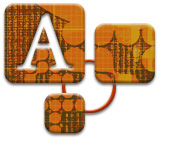|
 Topic
A7.2: Identifying and Assessing Available Technologies Topic
A7.2: Identifying and Assessing Available Technologies
Answering the Question "What"
This brings us to our next question: What?
What are the technologies that will allow us to incorporate all essential
components into our online or on-campus classroom?
To answer this question, we need
to consider another form of grouping: synchronous versus asynchronous.
The following sections provide lists of technologies that are typically
found in course management systems (CMS) used to delivery online courses
or to enhance campus-based courses.
Content Delivery technologies
support the delivery, presentation, and/or exchange of instructional
materials. Examples of technology that can be used for content delivery
are listed below:
1) Synchronous
a. Virtual Reality
b. Simulation
c. Online whiteboard
d. Document sharing
2) Asynchronous
a. Web pages
b. Television
c. Video
d. Animation
e. Databases
f. Document sharing
Collaboration technologies foster
communication and can be either synchronous or asynchronous. Some examples
are listed below:
1) Synchronous
a. Chat
b. Teleconference
c. Videoconference
d. Online whiteboard
2) Asynchronous
a. Email
b. Email Lists
c. Usenet groups
d. Bulletin boards/discussions
Assessment/Assignment technologies
provide the student the opportunity to demonstrate their knowledge,
skills, or abilities. Examples of such technology include the following:
1) Assessment - Asynchronous
a. Graded online quizzes and exams
b. Self assessment quizzes
2) Assignment delivery -
Asynchronous
a. Web pages
b. Word processed documents
c. Spreadsheets
d. Presentations
Course Management technologies
coordinate and facilitate the administrative aspects of teaching. For
example, Asynchronous functions would include the following:
a. Grade Tracking and Delivery
b. Student Activity Tracking
| Learning
Activity III - Answering the Question "What" |
Before selecting the technology that
best suits your instructional needs, you need to explore what it
takes to use these technologies and how they may or may not be
effective. Conduct one or two interviews (either face-to-face or
via an online discussion) with faculty who have used synchronous
and/or asynchronous technologies and ask what they'd recommend.
Ask them questions such as these:
1) Why did you choose this technology?
2) What benefits do you think or know your students gained from using
this technology?
3) What preparation did you have?
4) Were there any limitations?
5) What successes have you experienced?
6) What problems did you anticipate and what problems came up unexpected?
7) Did you experience any workload changes for yourself or your students?
If so, how did you adjust for them?
|
Now, let's see how what you discovered compares to the
research.
Check the Research
Dr. Barry Ellis, a professor at the University of Calgary and president
of DETAC Corporation, presented a perspective on technology in teaching
in a paper entitled "Virtual
Classroom Technologies for Distance Education: The Case for On-line
Synchronous Delivery,” presented at the North American Web
Developers Conference in October 1997. In it, he discussed these topics:
1) The Concept of the Virtual Classroom
2) The Student Settings
3) Group versus Individual Model
4) Role of the Media
5) Teacher Preparation
6) Instructional Content
7) Features of a Typical Synchronous System
8) Working Solution, Tested Paradigm
 
TOP
|